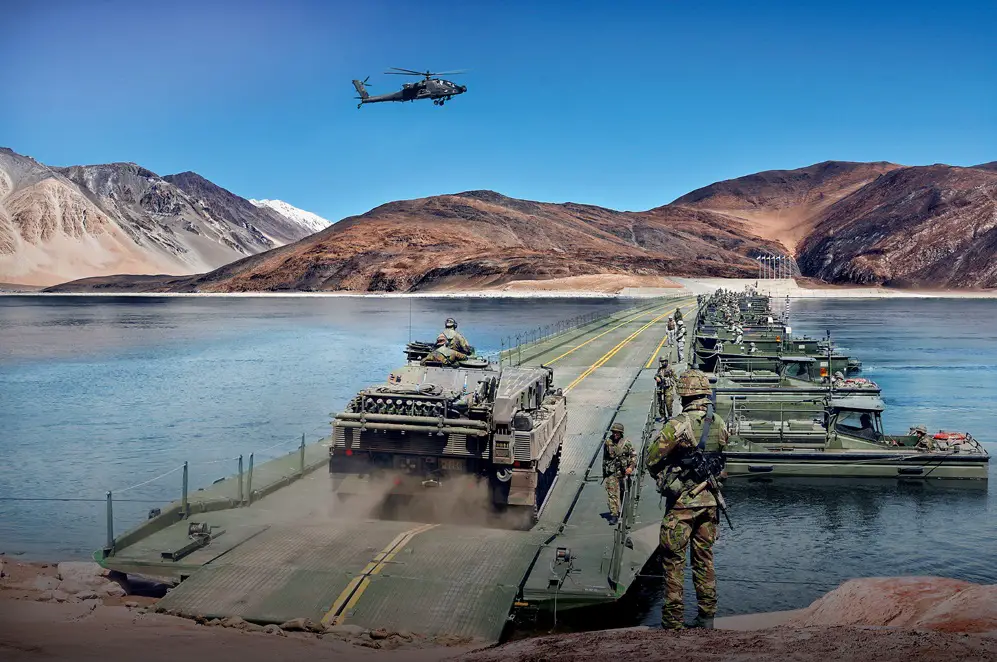In an effort to bolster their floating bridging capabilities, the Netherlands Ministry of Defence has recently procured three advanced systems, enabling the establishment of a substantial cross-river connection spanning 225 meters. General Dynamics European Land Systems – Bridge Systems has been awarded the contract, solidifying the military organization’s commitment to strengthening its operational infrastructure. The initial deployment of the first system is expected to take place in early 2025, with subsequent installations following no later than a year thereafter. This comprehensive acquisition encompasses middle and end pontoons, as well as boats designed to facilitate the seamless movement of bridge components across water bodies. Complementing this setup are specialized means for the transportation of bridge sections and boats on land, alongside bridge adapter pallets that facilitate the efficient launching and retrieval of equipment from the water. Additionally, the purchase includes extra pontoons and boats dedicated to training exercises.

The self-sufficiency of army personnel in constructing bridges is of utmost importance for their mobility. This capability enables them to traverse wide rivers and other aquatic obstacles, whether in the context of operational deployments or in providing assistance to civil authorities during emergencies such as flood disasters. Notably, the Nijmegen Four Days Marches, an annual walking event, sees soldiers erecting a pontoon bridge over the Maas near Cuijk—a testament to the practicality and significance of such bridging capabilities. Replacing outdated pontoon bridges dating back to 1985, the Netherlands Ministry of Defence has prioritized the acquisition of these new systems. The modernized equipment surpasses its predecessors by offering enhanced suitability for high water flow rates and increased maximum load capacity. Furthermore, the new systems contribute to the safety of military personnel and the environment by reducing (engine) noise and emissions of harmful substances.

The GDELS Improved Ribbon Bridge (IRB) provides wet-gap crossing capabilities either as a floating bridge or as a multi-bay raft for tracked and wheeled combat and tactical vehicles for loads up to MLC 80T/96W. IRB has seen extensive combat operations with the U.S. Army and the U.S. Marine Corps since 2003. It maintains full interoperability with the legacy SRB – Standard Ribbon Bridge and the FSB- Floating Support Bridge, which makes it the standard floating bridge in the Western hemisphere. The IRB provides state of the art loading capabilities up to MLC 80 (T) / 96 (W) that can be crossed by all NATO MBTs such as the Leopard 2, M1A2 Abrams and the Challenger 2. It can operate in significant water currents, enabling all types of platform to cross a gap when used as part of a bridge or as a multi-bay ferry. It is interoperable with other bridging solutions – the M3 and SRB (Standard Ribbon Bridge)/FSB(Floating Support Bridge). We also offer coupling devices to ensure the right interface at any time.

The IRB – Improved Ribbon Bridge have been successfully used in allied maneuvers such as Anakonda 2016 in Poland or in real combat zones (Iraq) allowing military operations to keep flowing regardless of the combat theater. IRB offers superior performance and reliability under differing climate conditions in exercises and combat operations. Tactical deployability is guaranteed as it can be transported by rotary aircraft, on trucks or on railway flatbed cars. That makes the IRB the right fit for coalitions which use different types of equipment but operate jointly. If necessary, the IRB can be supported by a BEB (Bridge Erection Boat) which provides the user with a high performance multipurpose boat. Low maintenance needs and ease for long-term storage help contribute to the IRB’s reasonable life cycle costs. Transport needs are also reduced thanks to its modular design. Combat experience is the key to linking a customer’s engineering needs with real combat environment, to be able to offer them robust, customized and realistic solutions which result in lower maintenance/upgrading costs during the bridge’s life cycle.
















